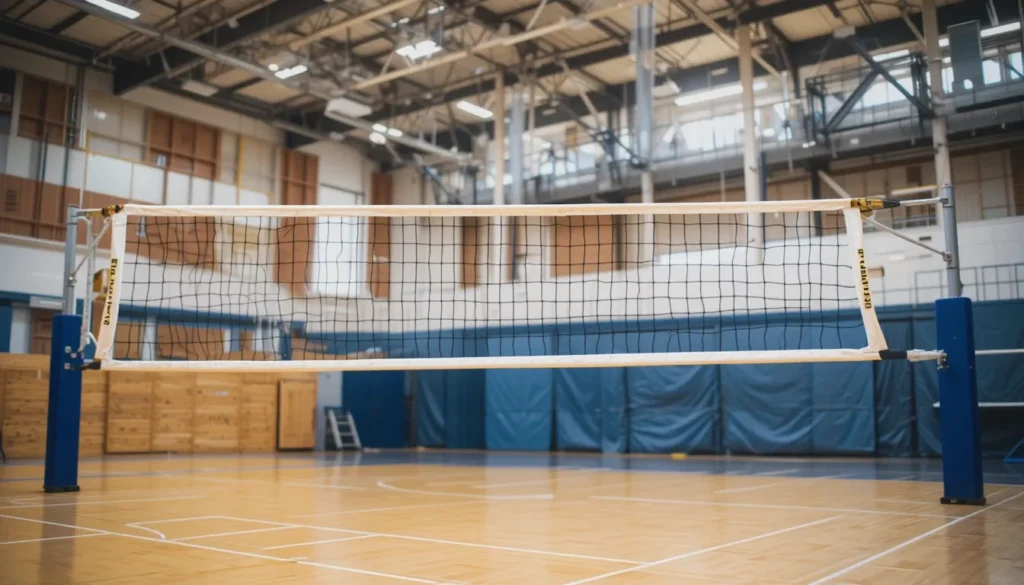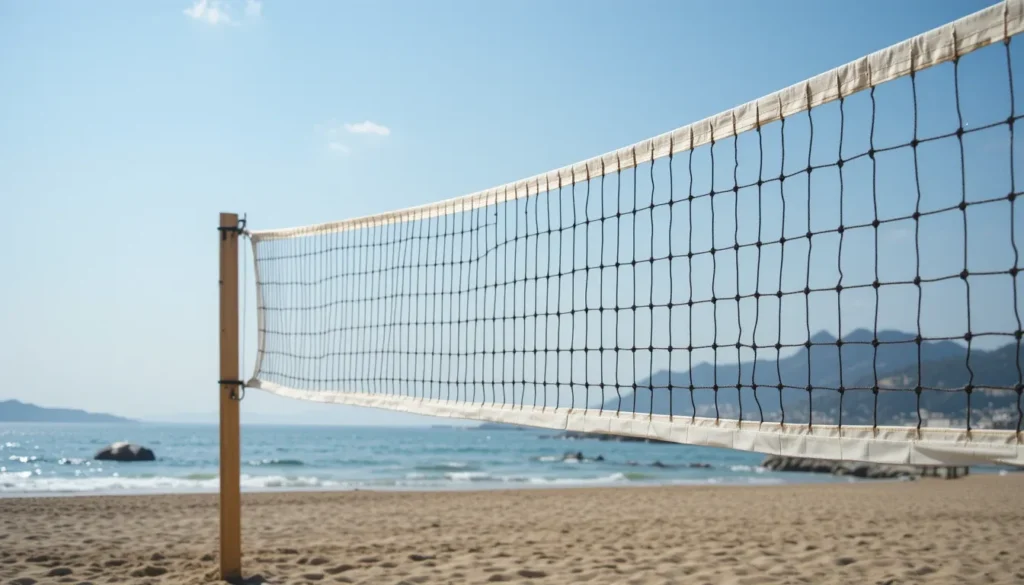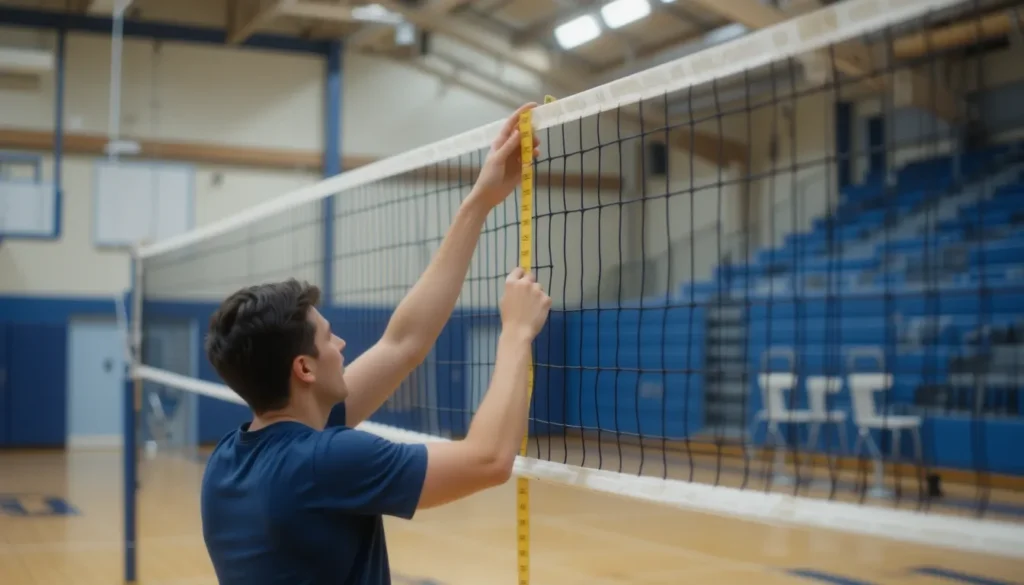Introduction to volleyball net height
Volleyball is a sport loved by millions worldwide, played both recreationally and professionally. One of the most crucial elements in the game is the volleyball net height, as it directly impacts gameplay, strategy, and fairness. Whether you’re a beginner, a coach, or a competitive player, understanding the standard volleyball net height is essential for setting up a proper court.
Different leagues, age groups, and game variations, such as indoor volleyball, beach volleyball, and sitting volleyball, follow specific net height regulations. For instance, the men’s volleyball net height differs from the women’s volleyball net height, and youth volleyball leagues have their own standards.
In this guide, we’ll cover official volleyball net height regulations, how to measure volleyball net height correctly, and key differences between various volleyball formats. By the end, you’ll have a clear understanding of how net heights vary and why they matter in ensuring a fair and competitive game.
Standard Volleyball Net Heights
The official volleyball net height varies depending on the league, gender, and type of game being played. The standard volleyball net height for men’s and women’s competitions follows international regulations set by organizations like FIVB (International Volleyball Federation) and USA Volleyball (USAV).

Men’s Volleyball Net Height
- The official net height for men’s indoor volleyball is 7 feet 11 ⅝ inches (2.43 meters).
- This height is used in professional leagues, college, and high school competitions.
- Recreational and co-ed games may follow different net height adjustments.
Women’s Volleyball Net Height
- The standard net height for women’s indoor volleyball is 7 feet 4 ⅛ inches (2.24 meters).
- This height is used in professional, collegiate, and high school leagues.
Co-Ed Volleyball Net Height
- In mixed-gender games, net height usually follows men’s official regulations (7 feet 11 ⅝ inches).
- Some leagues allow adjustments based on skill level and player agreement.
These measurements ensure fair play, consistent competition, and proper skill development. However, youth volleyball net heights and special game formats, such as beach volleyball and sitting volleyball, follow different net height rules, which we will cover in the upcoming sections.
Volleyball Net Heights by Age Group
Volleyball isn’t just for adults—players of all ages enjoy the game. To ensure fair play and proper skill development, youth volleyball net heights are lower than professional standards. Different age groups follow specific height regulations to match their physical abilities.

Youth Volleyball Net Heights
- Boys & Girls (10 & under): 6 feet 6 inches (1.98 meters)
- Girls (Ages 11-12): 7 feet (2.13 meters)
- Boys (Ages 11-12): 7 feet (2.13 meters)
- Girls (Ages 13-18): 7 feet 4 ⅛ inches (2.24 meters) (same as adult women’s height)
- Boys (Ages 13-14): 7 feet 4 ⅛ inches (2.24 meters)
- Boys (Ages 15-18): 7 feet 11 ⅝ inches (2.43 meters) (same as adult men’s height)
High School & College Volleyball Net Heights
- Girls’ high school volleyball: 7 feet 4 ⅛ inches (2.24 meters)
- Boys’ high school volleyball: 7 feet 11 ⅝ inches (2.43 meters)
- College volleyball follows the same standards as professional play.
Senior & Recreational League Net Heights
- Some recreational and senior volleyball leagues lower the net for ease of play.
- Adjustable net systems allow flexibility for different skill levels.
Senior Volleyball Net Adjustments
Volleyball net heights can be adjusted for senior players to accommodate different skill levels and physical requirements. Here are the standard net height adjustments for senior men and women:
- Men (55-69 years): The net height may be lowered to 7 feet 9 5/8 inches (2.38 meters) to allow better playability.
- Men (70 and over): The official net height for older male players can be reduced to 7 feet 6 inches (2.29 meters).
- Women (45 and over): The net height can be adjusted to 7 feet 2 1/8 inches (2.19 meters) for improved accessibility.
These age-based volleyball net heights ensure that younger players can develop their techniques properly without unnecessary difficulty. Next, we’ll explore how net heights differ between indoor and outdoor volleyball.
Indoor vs. Outdoor Volleyball Net Heights
While the basic rules of volleyball remain the same, net height variations exist between indoor and outdoor volleyball due to differences in playing surfaces and conditions.
Indoor Volleyball Net Heights
- Men’s indoor volleyball: 7 feet 11 ⅝ inches (2.43 meters)
- Women’s indoor volleyball: 7 feet 4 ⅛ inches (2.24 meters)
- Youth and high school net heights follow the same age-based standards discussed earlier.
Indoor volleyball is played on a hard court, allowing for faster movement and higher jumps, which is why the standard net height remains consistent across competitions.
Outdoor Volleyball Net Heights
Outdoor volleyball, including grass volleyball and sand volleyball, generally follows the same net height rules as indoor volleyball. However, beach volleyball has its own standardized heights:
- Men’s beach volleyball: 7 feet 11 ⅝ inches (2.43 meters)
- Women’s beach volleyball: 7 feet 4 ⅛ inches (2.24 meters)
- Co-ed and mixed-gender beach volleyball: Typically follows men’s net height regulations.
Since beach volleyball is played on sand, jumping is more challenging, but the net height remains unchanged. Up next, we’ll dive into the specifics of beach volleyball net height regulations and why they matter.
Beach Volleyball Net Heights
Beach volleyball is a popular variation of the game, played on sand courts with different movement dynamics compared to indoor volleyball. Despite the challenging surface, beach volleyball net heights remain the same as indoor volleyball.
Official Beach Volleyball Net Heights
- Men’s beach volleyball: 7 feet 11 ⅝ inches (2.43 meters)
- Women’s beach volleyball: 7 feet 4 ⅛ inches (2.24 meters)
- Co-ed beach volleyball: Usually follows the men’s net height.
Why Beach Volleyball Uses the Same Net Heights
Unlike indoor volleyball, where players rely on quick footwork and high jumps, beach volleyball players must adjust to sand’s resistance, which naturally slows movements and reduces jump height. Keeping the same net height for both formats ensures that the game remains competitive and skill-based.
Youth Beach Volleyball Net Heights
For younger players, youth beach volleyball leagues may lower the net height according to standard youth indoor volleyball guidelines. This allows developing players to focus on their techniques without unnecessary difficulty.
Beach volleyball’s unique playing conditions make it an exciting and physically demanding sport. Up next, we’ll explore how sitting volleyball modifies net height for adaptive gameplay.
Impact of Wind and Sand on Beach Volleyball Net Setup
In beach volleyball, external conditions like wind and sand play a crucial role in net setup and stability.
- Wind Impact: Strong winds can cause excessive net movement, affecting gameplay. To counter this, net tension is often adjusted, and additional tie-downs or weighted anchors are used to keep the net stable. Some courts also use windscreen barriers to minimize the impact of gusts.
- Sand Conditions: The softness and depth of sand influence pole stability. In loose or deep sand, poles may shift over time, requiring frequent adjustments. Properly anchored poles and wider base plates help maintain net height and tension, ensuring consistent play.
By considering these factors, players and organizers can set up a stable and well-maintained net for beach volleyball, even in challenging weather conditions.
Sitting Volleyball Net Heights
Sitting volleyball is a fast-paced and competitive version of volleyball designed for athletes with physical impairments. Since players remain seated on the court, the net height is significantly lower than in standing volleyball.
Official Sitting Volleyball Net Heights
- Men’s sitting volleyball: 3 feet 9.28 inches (1.15 meters)
- Women’s sitting volleyball: 3 feet 5.34 inches (1.05 meters)
Why the Net is Lower in Sitting Volleyball
Since players move using their arms and upper body strength rather than jumping, a lower net height ensures fair play and allows for dynamic, fast-paced rallies.
Sitting volleyball is recognized by the International Paralympic Committee (IPC) and follows the official rules set by World ParaVolley. This version of volleyball is played at both recreational and professional levels, making it an inclusive and exciting sport.
Next, we’ll discuss how to accurately measure volleyball net height to ensure proper setup.
How to Properly Measure Volleyball Net Height
Ensuring the correct volleyball net height is crucial for fair play. Follow these key takeaways to accurately measure and set up your net.

Step-by-Step Guide to Measuring Net Height
- Measure from the center
- Always check the net height from the middle, as sagging can occur on the sides.
- Always check the net height from the middle, as sagging can occur on the sides.
- Use a measuring tape
- Extend a tape measure from the net’s center to the court surface for precise height verification.
- Extend a tape measure from the net’s center to the court surface for precise height verification.
- Check side pole height
- The net’s ends should not be more than ¾ inch (2 cm) higher than the center to ensure even tension.
- The net’s ends should not be more than ¾ inch (2 cm) higher than the center to ensure even tension.
- Adjust net tension
- Tighten the net tensioning system if there is sagging to maintain a level height.
- Tighten the net tensioning system if there is sagging to maintain a level height.
- Verify with official rules
- Compare the measured height with FIVB, USA Volleyball, or local league regulations to ensure accuracy.
- Compare the measured height with FIVB, USA Volleyball, or local league regulations to ensure accuracy.
Common Mistakes to Avoid
- Measuring from the sidelines instead of the center, which can lead to incorrect net height.
- Using a loosely secured net, causing shifts in height during gameplay.
- Ignoring different net height standards, especially for youth, men’s, and women’s competitions.
By following these guidelines, you can properly set up a regulation volleyball net for competitive and recreational play. Up next, we’ll examine how various organizations regulate volleyball net heights.
Volleyball Net Height Regulations by Different Organizations
Different volleyball organizations have their own official net height regulations to ensure standard gameplay across various levels. Below is a breakdown of key organizations and their regulations.
Fédération Internationale de Volleyball (FIVB) & USA Volleyball (USAV)
- Men’s net height: 7 feet 11 ⅝ inches (2.43 meters)
- Women’s net height: 7 feet 4 ⅛ inches (2.24 meters)
- Co-ed & mixed play: Usually follows men’s height unless specified otherwise.
National Collegiate Athletic Association (NCAA)
- Follows FIVB and USAV standards for men’s and women’s divisions.
- College volleyball emphasizes official net height accuracy for competitive fairness.
National Federation of State High School Associations (NFHS)
- Men’s high school volleyball net height: 7 feet 11 ⅝ inches (2.43 meters)
- Women’s high school volleyball net height: 7 feet 4 ⅛ inches (2.24 meters)
- Middle school volleyball nets: Slightly lower, often around 7 feet (2.13 meters).
International Paralympic Committee (IPC) – Sitting Volleyball
- Men’s sitting volleyball: 3 feet 9.28 inches (1.15 meters)
- Women’s sitting volleyball: 3 feet 5.34 inches (1.05 meters)
Understanding these regulations ensures proper setup for various competition levels. Next, we’ll discuss adjusting volleyball nets for different playing conditions.
Adjusting Volleyball Nets for Different Playing Conditions
Volleyball is played in various environments, including indoor courts, outdoor sand courts, and recreational settings. Adjusting the volleyball net height based on the playing conditions ensures a fair and enjoyable game.
1. Indoor vs. Outdoor Volleyball Nets
- Indoor volleyball nets are installed using fixed poles with adjustable settings for men’s, women’s, and youth play.
- Outdoor volleyball nets (beach or grass courts) require manual height adjustments, often using adjustable straps or tensioning systems.
2. Beach Volleyball Net Adjustments
- Men’s beach volleyball net height: 7 feet 11 ⅝ inches (2.43 meters)
- Women’s beach volleyball net height: 7 feet 4 ⅛ inches (2.24 meters)
- Outdoor conditions like wind and sand movement can impact net stability, so extra tightening may be required.
3. Adjustable Nets for Recreational Play
- Many portable and backyard volleyball nets come with adjustable poles, allowing players to modify the height for different skill levels.
- Casual play and youth games often require lowering the net for better accessibility.
4. Net Tension & Stability
- Proper tensioning systems prevent excessive sagging.
- Use anchors or weighted bases for outdoor courts to keep the net stable.
Making the right adjustments for different volleyball settings improves gameplay quality. Up next, we’ll explore how net height impacts performance and strategy.
Also Read : Triple Threat Basketball: Master the Ultimate Offensive Move
Conclusion
The height of a volleyball net is a fundamental aspect of the game, impacting strategy, performance, and fairness across different levels. Whether for men, women, youth, or sitting volleyball, understanding official net height regulations ensures a level playing field.
Throughout this guide, we’ve covered the official net height standards, why they vary, and how different governing bodies enforce them. We also explored how net height affects gameplay, key training techniques, and common mistakes to avoid.
For players and coaches, adapting to different net heights is essential for improving skills like spiking, blocking, and serving. By training under varied net conditions, ensuring proper net setup, and refining techniques, players can enhance their performance in any game setting.
Ultimately, mastering net height rules goes beyond regulations—it helps players optimize their skills and gain a competitive edge on the court.
FAQs
1. What is the standard height of a volleyball net?
The standard volleyball net height is 7 feet 11 ⅝ inches (2.43 meters) for men and 7 feet 4 ⅛ inches (2.24 meters) for women, as set by FIVB and USA Volleyball.
2. How was the standard volleyball net height determined?
The net height was established based on factors like average player height, athletic capabilities, and competitive balance to ensure fair and skill-based gameplay.
3. What is the net height for a co-ed volleyball game?
In most co-ed games, the net height follows the men’s regulation height of 7 feet 11 ⅝ inches (2.43 meters) unless modified by specific league rules.
4. How tall should a volleyball net be, and why?
A volleyball net should be set at the official height to maintain fairness, support skill development, and ensure consistent competition across different levels of play.

6 thoughts on “Volleyball Net Height: Official Measurements & Guide”
I think everything published made a ton of sense.
But, consider this, suppose you wrote a catchier title? I am not saying your information isn’t good.,
but what if you added a title that makes people want more?
I mean Volleyball Net Height: Official Measurements & Guide is a little plain. You might look at Yahoo’s home page and note how they
create article titles to grab viewers to click.
You might add a related video or a related pic or two to grab readers interested about
everything’ve written. In my opinion, it would bring
your blog a little bit more interesting. https://sun-clinic.co.il/he/question/%d0%bf%d1%80%d0%be%d1%81%d1%82%d0%b8%d1%82%d1%83%d1%82%d0%ba%d0%b8-%d1%8d%d0%bd%d0%b3%d0%b5%d0%bb%d1%8c%d1%81%d0%b0/
suggest me title for my blog
It’s enormous that you are getting thoughts from
this article as well as from our dialogue made here.
Keep on writing, great job!
Thanks very nice blog!
Thanks a bunch for sharing this with all of us you actually realize
what you are talking about! Bookmarked.
Kindly additionally discuss with my website =).
We could have a link change contract between us